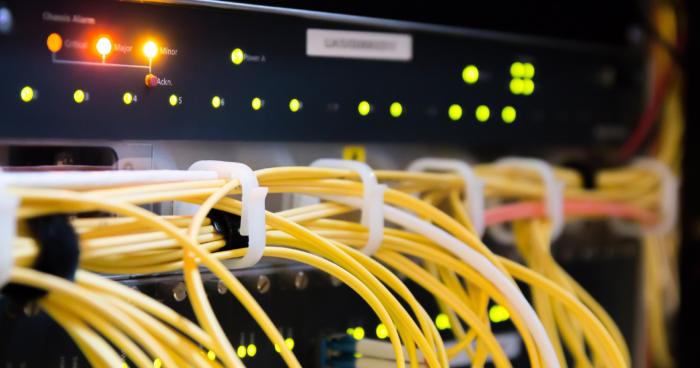Both UDP and TCP protocols play a great role in how we communicate with others and with the internet itself.
However, not many people know what exactly they do and what’s the difference.
That’s why we wrote this compelling UDP Vs. TCP comparison that looks at the advantages and disadvantages of each of these protocols and helps consumers understand them better when setting up their network.
Chances are, you stumbled upon at least one of these protocols when setting up your network, going through your VPN settings, or setting up your firewall.
Which one you should use depends on your individual use case and what you’re trying to achieve.
Before you can understand the difference between UDP and TCP protocol, continue reading to learn more about these protocols and their key features.
We’ll also detail when you should use them and mention some real-life examples.
1. What Is TCP?
TCP (Transmission Control Protocol) is the most commonly used networking protocol. We use it daily, from surfing the internet, chatting with our friends to shopping online and transferring files with the help of other networking protocols.
Its widespread use case is thanks to its reliability and security standards.
Connection is the key aspect of TCP protocol. In order for someone to be able to send a message or file, we need to establish a reliable connection between two devices that will exchange data, and make sure that it’s stable throughout the time data is transferred.
TCP protocol uses a special process to ensure that two devices are connected and ready to exchange text, photos, or files.
The process, known as a three-way-handshake first initiates the connection between two devices and then receives feedback that the two devices are connected.
After that, the first device sends data to the other device and TCP controls the packets on their way to the destination.
Once the text, photo, or file transmission is complete, TCP terminates the connection.
In the process of controlling the packet transmission, the TCP protocol has built-in mechanisms that can check whether the packets arrived at their destination and whether an error occurred.
TCP protocol guarantees that all data will be transferred to the other router. Otherwise, if an error occurred, the devices would need to re-establish the connection and send data again.
Even though it’s quite reliable and comes with advanced error checking, the three-way-handshake makes it slower. TCP processes are slow at the beginning, which makes downloading larger streams of data slower in the process.
2. What Is UDP?
UDP (User Datagram Protocol) is another important networking protocol, but much simpler compared to TCP.
It is connectionless, which means there’s no requirement for checking errors and processes such as three-way-handshake. While TCP has data recovery mechanisms, UDP doesn’t use them.
How does that work? UDP protocol is used in data transmission which is continuously traveling from one device to another.
It doesn’t have mechanisms that will initiate, maintain, or terminate the connection. Instead, packets are constantly being sent, without controlling whether they reached the recipient without errors.
That makes its use case completely different. While TCP was used with other protocols in communication like sending messages and emails, loading a website, or transferring files, UDP is used in live communication or streaming.
A conference call or video game live stream are good examples of UDP in action. If one device disconnects from the stream and then gets back on, the viewer isn’t picking up from where he left.
The stream kept going and other viewers continued watching so the person who disconnected and came back continues watching in real-time. That’s why UDP is often referred to as “fire-and-forget-protocol.”
3. UDP vs TCP: The Similarities
Both UDP and TCP are very important network protocols. They both operate atop Internet Protocol (IP) to transmit special data packets known as datagrams from one device to others.
Those tiny bits of data hold fragments of our messages that we send to our friends as well as page requests to view different websites.
Both protocols can control different ports to be able to send data packets to different destinations until they reach the final IP address of the receiver.
In other words, both these protocols transmit data, using different mechanisms and requirements.
To understand those mechanisms, let’s look at the UDP Vs. TCP comparison with more detail.
4. UDP Vs. TCP: What Is the Difference?
If the definition didn’t explain how these two protocols are different, this table below breaks down the key differences.
| TCP | UDP | |
| Connection | Connection-based | Connectionless |
| Speed | Slow | Fast |
| Error Checking | Yes | No |
| Reliability | Reliable | Not reliable |
| Sequencing Data | Yes | No |
| Transfer | Stream of data packets | Packets are sent one by one |
| Broadcasting Support | No | Yes |
| Uses | HTTP, HTTPS, SMTP, POP, FTP, SFTP | DNS, VoIP, video conferencing, streaming, etc. |
4.1 Connection
While TCP is a connection-based protocol, UDP is connectionless. That means that it won’t establish and check whether the connection is established before sending data packets to the receiver.
TCP will establish a connection using a three-way-handshake, also known as TCP handshaking and after the connection is established, it’ll send a stream of data packets.
UDP won’t check whether the receiver received the data packets it sent. They are sent individually, without establishing a connection beforehand.
4.2 Speed
The UDP protocol being faster than TCP is nearly self-explanatory.
Unlike UDP, TCP protocol establishes and acknowledges the connection between two endpoints. Each time it should send a stream of data, the protocol will re-acknowledge the connection and check if any error occurred.
After an error occurred and there has been a negative acknowledgment, TCP needs to re-establish the connection between two parties and perform the TCP handshake process to confirm that the errors have been cleared.
The UDP protocol doesn’t perform any type of handshake or check if the connection broke, it’ll continue to send data packets one by one until the transmission is complete.
It also won’t check whether the two devices are still connected or not. This process makes it significantly faster compared to TCP, which is why it’s used in conference calls.
4.3 Error Checking
TCP checks for errors and attempts to fix them once they are detected while aborting the transmission meanwhile. Once the errors are fixed, TCP will attempt to re-establish the connection and get acknowledgment that now it’s safe to send streams of data again.
UDP doesn’t have any advanced system or mechanism that allows it to check for errors.
However, it uses checksum which calculates the sum derived from the bits of datagram, comparing it to the transmitted checksum.
If the error occurred, some implementations of the UDP protocol will just discard the corrupted or damaged datagram. Some other implementations send the datagram with a warning that it has been corrupted.
4.4 Reliability
Given its connection establishing and error checking advantages, we can freely say that TCP protocol is more reliable than UDP protocol. It guarantees to delivery of the data to the final destination, while UDP doesn’t come with such a guarantee.
If some packet gets corrupted during the transmission, TCP will recover it and re-attempt the transmission. UDP protocol deals with corrupted datagrams in the same way as it was detailed in the error checking section.
4.5 Data Sequencing
Data sequencing is one of the key features of TCP. Data sequencing enables the user to receive the data packets in order that they were sent, making sense of the message that was sent by the sender.
UDP doesn’t have a data sequencing mechanism. In case datagrams need to be sent in a special order by the UDP protocol, the application layer (the 7th layer in the OSI model framework) manages how they’ll be sent.
4.6 Data Transfer
The receiver receives a stream of data packets when the data is being sent through TCP. However, UDP processes its packets individually.
A data stream doesn’t have a defined boundary for the packets that are sent. On the other hand, each individual packet sent through the UDP protocol has predefined boundaries which are checked for integrity once they arrive at the destination.
4.7 Broadcasting Support
Because of its complex structure and reliability mechanisms, TCP doesn’t have broadcasting features.
On the other hand, the UDP protocol supports broadcasting, which is the key feature for its application today.
4.8 Uses
UDP protocol is used mostly for broadcasting. That can include conference calls, VoIP, live streaming, and other forms of broadcasting. TCP protocol has much more widespread use.
It is used with HTTP and HTTPS protocols for viewing web pages. In combination with SMTP and POP3 protocols, it can be used to read and send emails. It also works with FTP protocol to enable file download and transfer.
5. Conclusion: Which to Choose?
We hope that this article helped you understand the difference between UDP Vs. TCP. If you still don’t know which protocol you should go with for your business or personal use, you should ask yourself what you want from your network.
If reliability and error resolution is the first thing that comes up to your mind when using your network, TCP should be your first choice.
If you’re looking for a faster solution and you or your business benefit from virtual communication and broadcasting, then you should go with UDP.
We earn commissions using affiliate links.



![BitTorrent vs uTorrent [year] – Key Differences & Best Choice BitTorrent vs uTorrent 2021](https://www.privateproxyguide.com/wp-content/uploads/2019/02/bittorrent-vs-utorrent-150x150.jpg)
![VDI vs VPN vs RDS [year] Key Differences Explained VDI vs VPN vs RDS](https://www.privateproxyguide.com/wp-content/uploads/2022/01/VDI-vs-VPN-vs-RDS-150x150.jpg)
![Best UDP VPN [year]: Fast & Reliable UDP Servers Best UDP VPN](https://www.privateproxyguide.com/wp-content/uploads/2022/01/Best-UDP-VPN-150x150.jpg)
![Is Mobdro Legal and Safe to Use in in [month] [year]? Is Mobdro Legal and Safe to Use](https://www.privateproxyguide.com/wp-content/uploads/2020/10/Is-Mobdro-Legal-and-Safe-to-Use-150x150.jpg)
![Best DNS Filtering Solutions [year] for Businesses and Home Use Best DNS Filtering Solutions](https://www.privateproxyguide.com/wp-content/uploads/2022/05/Best-DNS-Filtering-Solutions-150x150.jpg)
![Best Email Clients for Business and Personal Use [year] Best Email Clients](https://www.privateproxyguide.com/wp-content/uploads/2022/06/Best-Email-Clients-150x150.jpg)
“UDP doesn’t have any system or mechanism that allows it to check for errors. If the error occurred some implementations of UDP protocol will just discard the corrupted or damaged datagram. Some other implementations send the datagram with a warning that it has been corrupted”
this is a contradictory statement. how does UDP discard corrupted packages if it has no mechanism to check for errors? UDP does have error checking in the form of a checksum. the difference between udp and tcp is that when tcp detects in error it will automatically retransmit where as udp will just drop the packet
Hi, thank you for pointing the error out. It’s worth noting that UDP checksum uses a simple algorithm, which means it won’t always detect all errors. We still updated the article to reflect this statement.